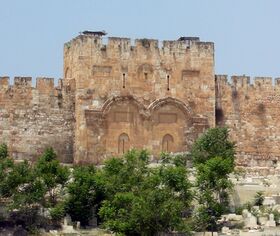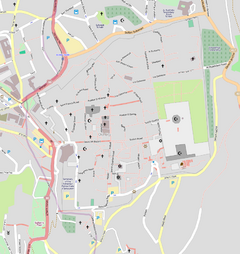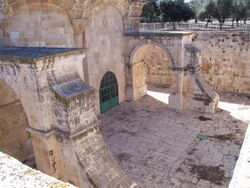Religion:Golden Gate (Jerusalem)
| Golden Gate | |
|---|---|
 Golden Gate | |
| General information | |
| Town or city | Jerusalem |
| Coordinates | [ ⚑ ] 31°46′44″N 35°14′13″E / 31.77889°N 35.23694°E |
The Golden Gate, as it is called in Christian literature, is the only eastern gate of the Temple Mount and one of only two that used to offer access into the city from that side. It has been walled up since medieval times. The date of its construction is disputed and no archaeological work is allowed at the gatehouse, but opinions are shared between a late Byzantine and an early Umayyad date.
The Hebrew name of the Golden Gate is Sha'ar HaRachamim (שער הרחמים), Gate of Mercy. In Jewish sources[dubious ] the eastern gate of the Temple compound is called the Shushan Gate. If the Golden Gate does preserve the location of the Shushan Gate, which is only a presumption with no archaeological proof, this would make it the oldest of the current gates in Jerusalem's Old City Walls. According to Jewish tradition, the Shekhinah (שכינה) (Divine Presence) used to appear through the eastern Gate, and will appear again when the Anointed One (Messiah) comes (Ezekiel 44:1–3) and a new gate replaces the present one; that might be why Jews used to pray in medieval times for mercy at the former gate at this location,[1] another possible reason being that in the Crusader period, when this habit was first documented, they were not allowed into the city where the Western Wall is located. Hence the name "Gate of Mercy".
In Christian apocryphal texts, the gate was the scene of the meeting between the parents of Mary after Saint Joseph's first dream, so that the gate became the symbol of the Immaculate Conception of Mary[2] and Joachim and Anne Meeting at the Golden Gate became a standard subject in cycles depicting the Life of the Virgin. It is also said that Jesus, riding on a donkey, passed through this gate on Palm Sunday, in fulfillment of the Jewish prophecy concerning the Messiah.[2] Some equate it with the Beautiful Gate mentioned in Acts 3.
In Arabic, it is known as Bab al-Dhahabi,[2] also written Bab al-Zahabi,[3] meaning "Golden Gate"; another Arabic name is the Gate of Eternal Life.[citation needed] Additionally, for Muslims each of the two doors of the double gate has its own name: Bab al-Rahma, "Gate of Mercy", for the southern one, and Bab al-Taubah, the "Gate of Repentance", for the northern one. Similar to Christians, Muslims generally believe this was the gate through which Jesus as Messiah, entered Jerusalem.
Construction history
The gate is located in the northern third of the Temple Mount's eastern wall. The present gate was probably built in the 520s AD, as part of Justinian I's building program in Jerusalem, on top of the ruins of the earlier gate in the wall.[citation needed] An alternative theory holds that it was built in the later part of the 7th century by Byzantine artisans employed by the Umayyad khalifs.[4] The Ottoman Turks transformed the walled-up gate into a watchtower.[4] On the ground floor level a vaulted hall is divided by four columns into two aisles, which lead to the Door of Mercy, Bab al-Rahma, and the Door of Repentance, Bab al-Taubah; an upper floor room has the two roof domes as its ceiling.[4]
The sealing of the gate
Closed by the Muslims in 810, reopened in 1102 by the Crusaders, it was walled up by Saladin after regaining Jerusalem in 1187. Ottoman Sultan Suleiman the Magnificent rebuilt it together with the city walls, but walled it up in 1541, and it stayed that way.[5]
Suleiman may have taken this decision purely for defensive reasons, but in Jewish tradition this is the gate through which the Anointed One (Messiah) will enter Jerusalem[6]. In relation to the Muslim belief Jesus of Nazareth is the Messiah, it is suggested [by whom?] that Suleiman the Magnificent sealed off the Golden Gate to prevent a false Messiah or "Antichrist" coming through entrance.[citation needed] The Ottomans also built a cemetery in front of the gate, to prevent a false precursor to the Anointed One, Elijah, from passing through the gate. [citation needed] This belief was based upon two premises. First, according to Islamic teaching Elijah is a descendant of Aaron,[7] making him a priest or kohen. Second, that a Jewish kohen is not permitted to enter a cemetery. This second premise is not wholly correct because a Kohen is permitted to enter a cemetery in which either Jews or non-Jews are buried, such as the one outside the Golden Gate, as long as certain laws or Halakha regarding purity are followed.[8]
In Christian culture
Honoring the Jewish tradition (see above) and inspired by apocryphal accounts of the life of the Virgin Mary, medieval Christian artists depicted the relationship of Jesus' maternal grandparents Joachim and Anne Meeting at the Golden Gate. The couple came to represent the Christian ideal of chastity in conjugal relations within marriage. The pious custom of a bridegroom carrying his bride across the threshold of their marital home may be based in the traditional symbolism of the Golden Gate to the faithful. In early medieval art, the now-formal tenet of the immaculate conception of the mother of Christ was commonly depicted in a form known in Italian as the Metterza: the three generations of grandmother, mother, and son.
The metaphor also features heavily in the personalist phenomenology of Pope John Paul II, his Theology of the Body, a collection of reflections on this theme Crossing the Threshold of Hope were written to encourage the Roman Catholic faithful facing the challenges of materialism and increasing secularism and published on the cusp of the new millennium in 1998. The threshold between the earthly and heavenly realms symbolized by the Golden Gate represents the Mystical Body of the Church, often viewed as the Bride of Christ.
In Christian eschatology, sunrise in the east symbolizes both Christ's resurrection at dawn on Easter Sunday and the direction of his Second Coming. Sanctuaries for Christian congregational worship at an altar are often arranged with respect to the east. City gates in Christian urban centers often contain religious artifacts intended to guard the city from attacks and to bless travelers. The Ostra Brama in Vilnius, Lithuania contains an icon of Our Lady of the Gate of Dawn, which is venerated by both Roman Catholic and Orthodox inhabitants.
Topography east of the Old City
The Golden Gate is one of the few sealed gates in Jerusalem's Old City Walls, along with the Huldah Gates, and a small Biblical and Crusader-era postern located several stories above ground on the southern side of the eastern wall.
References
| Wikimedia Commons has media related to The Golden Gate. |
- ↑ AJE - Jerusalem 3000 - The Golden Gate
- ↑ Jump up to: 2.0 2.1 2.2 "Bab al-Dhahabi". Archnet. http://archnet.org/sites/3061/media_contents/35257. Retrieved 27 September 2015.
- ↑ "IRCICA / ISLAMIC ARCHITECTURAL HERITAGE DATABASE". ircicaarchdata.org. http://www.ircicaarchdata.org/ircica/level1.php?id=29.
- ↑ Jump up to: 4.0 4.1 4.2 Eliyahu Wager (1988). Illustrated guide to Jerusalem. Jerusalem: The Jerusalem Publishing House. p. 32.
- ↑ Dr. J. Randall Price. Rose Guide To The Temple. Rose Publishing 2013. p. 135. ISBN 9781596364684. https://books.google.co.il/books?id=MtBDcXiJYzAC&pg=PA119&lpg=PA119&dq=Bab+al-Thulathe&source=bl&ots=J_GwQvufwz&sig=FXtyyc2I0KahNzLRmEL5gCD-Wg4&hl=en&sa=X&ved=0CDEQ6AEwBGoVChMIhLGSnJ6YyAIVge9yCh2iFQ1u#v=onepage&q=Bab%20al-Thulathe&f=false.
- ↑ http://www.goisrael.com/Tourism_Eng/Articles/Attractions/Pages/The%20Gates%20of%20Jerusalem.aspx
- ↑ Stories of The Prophets, Ibn Kathir, page 474
- ↑ The Kohen's Purity
[ ⚑ ] 31°46′44″N 35°14′13″E / 31.77889°N 35.23694°E




